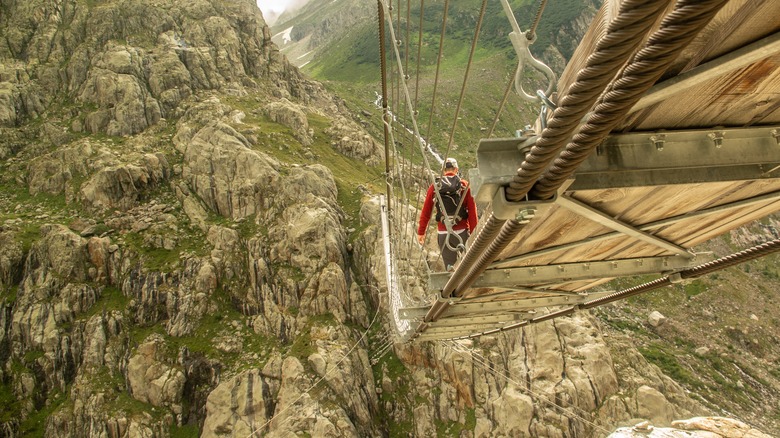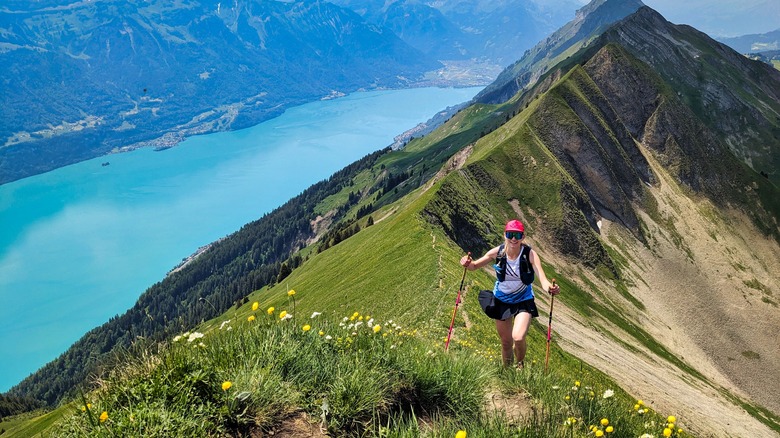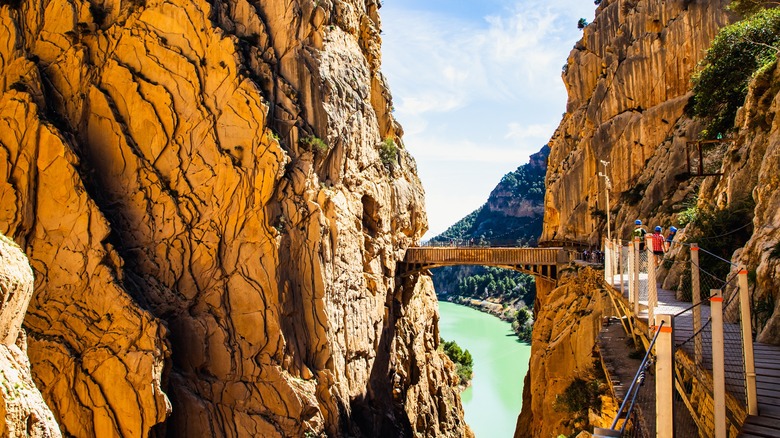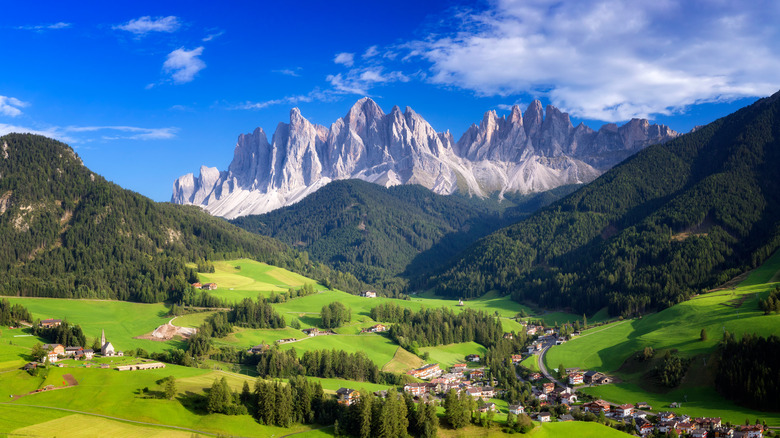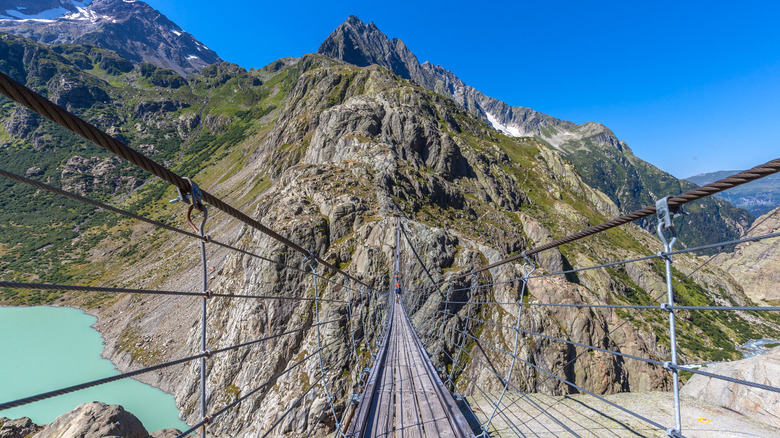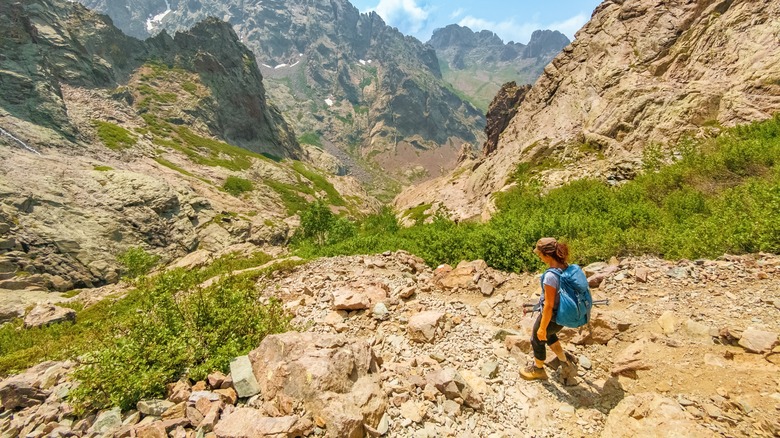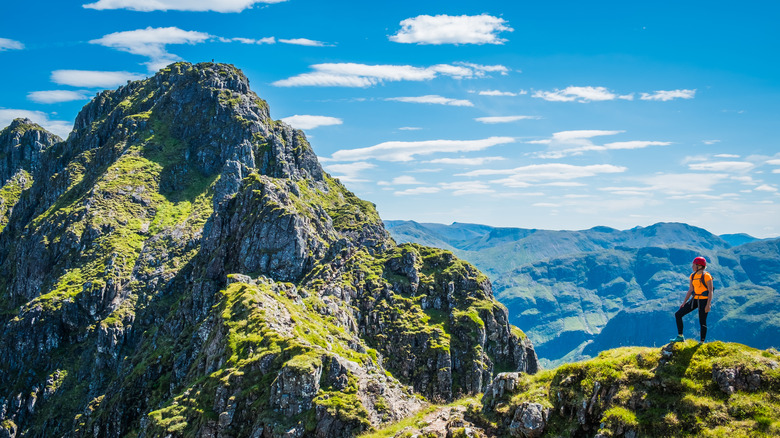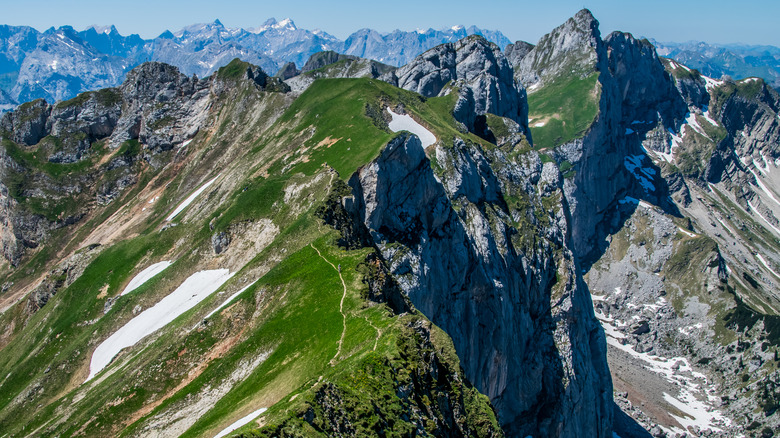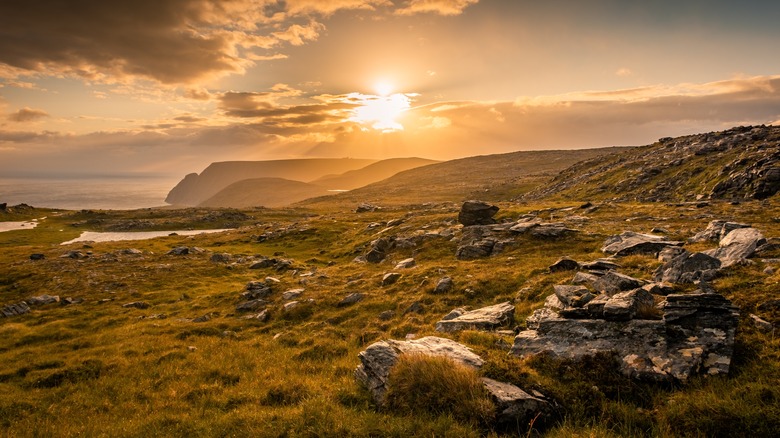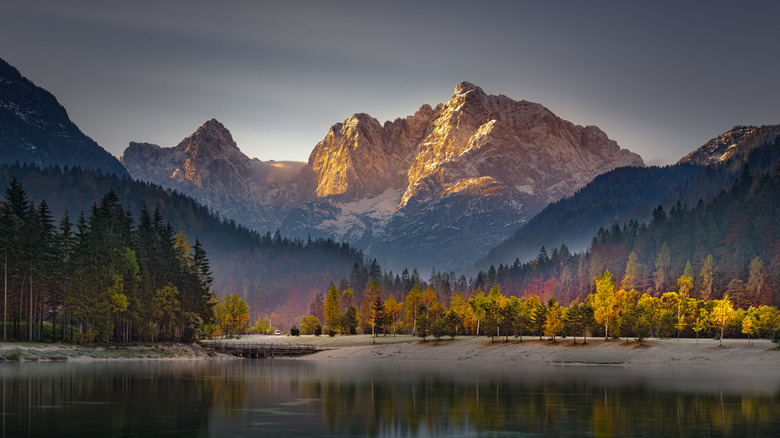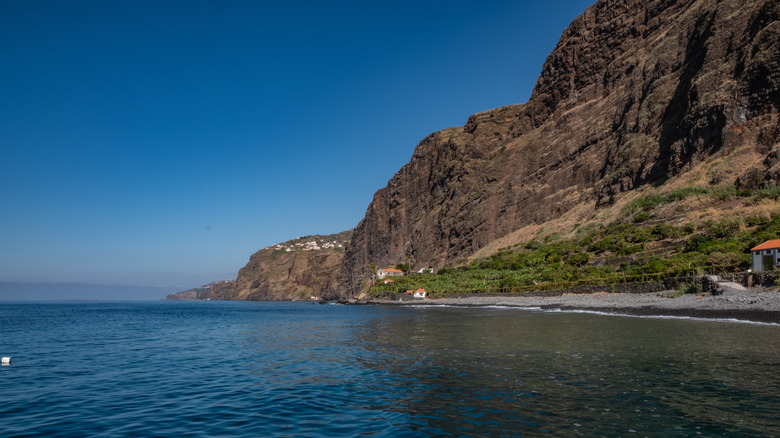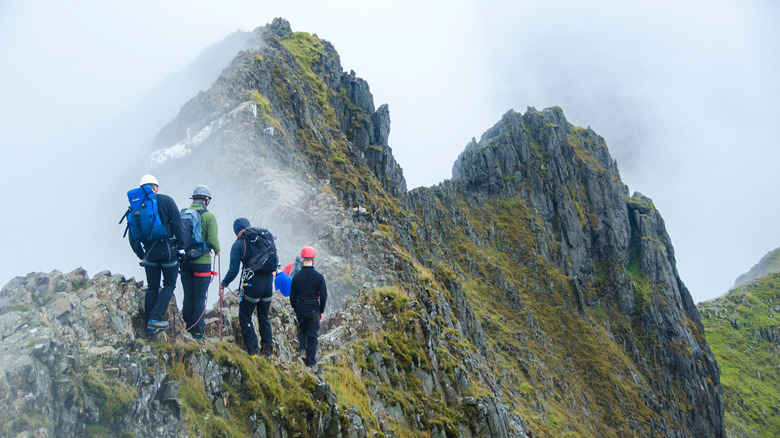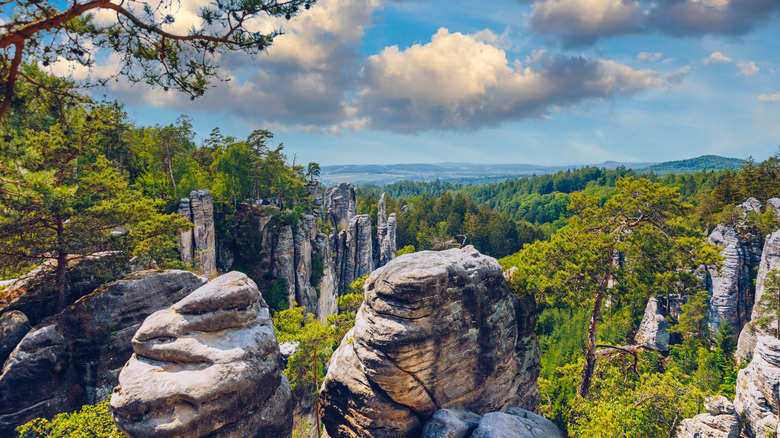Dangerous Hiking Spots To Avoid In Europe
If you were to look at a list of the top places in the world to travel to, many countries in Europe would surely crop up. With countless historic cities and a variety of vibrant cultures, it is easy to see why those who haven't been to Europe would want to experience it all. However, there is a wilder side to the continent that many travelers miss, even though most are not too far away from tourist hubs.
Many of these more out-of-the-way places are open to hiking, but we advise caution. Like other mountain hikes around the world, peaks in Europe offer some truly ethereal views. However, these views do come with a caveat; they should not be scaled by anyone except experienced hikers. To the average hiker, the destinations on this list are ones to want to avoid when traveling throughout Europe.
From the Dolomites of Italy to the Swiss Alps, the Spanish coastline, Corsican hills, and Romanian mountaintops, the following 12 hikes should not be underestimated. Every one of these is dangerous in its own right, so let's break them down.
Switzerland's Hardergrat is considered one of the most dangerous hikes in the world
At 16 miles long and with over 10,000 feet of elevation gain, the Hardergrat trail in Switzerland is considered by many to be one of the most dangerous hikes in the world (via Outside). To its credit, this section of the Swiss Alps provides unparalleled views of the surrounding Jungfrau region. However, as anyone who has visited the U.S. National Parks knows, views often come with a price.
The Hardergrat is what's known among hikers as a "knife edge." The trail is extremely thin, with steep, exposed drop-offs on either side. Owing to the verdant surroundings, much of the Hardergrat is covered in grass, which can become extremely slippery when wet. Even when conditions are bone dry, steady and focused footing is required to hike this trail safely.
Fortunately, deaths are not common, but they do occur. According to the Swiss newspaper Blick, in 2019, a hiker fell several hundred feet and died as a result of his injuries. The Hardergrat is not a trail that should be attempted by anyone who does not have experience with Alpine conditions or is without hiking poles.
How Spain's Caminito del Rey was dubbed 'The Walkway of Death'
Located near the town of Magala on Spain's southern coast, this trail has earned its title of the Walkway of Death (via Cicerone). The original steel beams and concrete walkways were built into the mountainside for workers building a nearby dam on the Guadalhorce River. Many laborers fell to their deaths working in cutting the stone needed to build the dam. So, the Caminito del Rey was designed for the project — not to survive long-term.
As such, the trail was left to crumble alongside nature, eroding with the mountain, rusting with the weather, and falling into general decay. Attempts were made to keep people off the trail, but thrill seekers still found ways to scramble along the rotting walkways. In the late 1990s, several people plummeted to their deaths in the gorge. Several meters of the trail were destroyed by the government of Spain, making access nearly impossible.
However, looking for a way to make the trail safer, the government spent the next 15 years refurbishing the trail with new, more secure walkways and security cameras. The site was reopened in 2015, and anyone who wants to walk the trail is required to wear a hard hat.
The Dolomites, Italy's dangerous tourist hotspot
Italy is one of the most visited countries in all of Europe. While many flock to famous cities like Rome, Florence, and Venice, there is another region that garners special attention for its dramatic beauty. The Dolomites are a section of the Italian Alps characterized by their jagged, toothsome spines. The mesmerizing peaks are a tourist hotspot in summer and winter, offering excellent opportunities to ski, hike, and climb.
However, there is a downside to this beauty. According to Alpine Exploratory, one of the Dolomites' most popular long-distance hiking trails is the Alta Via 1, a 75-mile trek through the heart of the region. Ascending 9,000 feet over its course, the conditions on the trail are less than ideal. Combine the tricky (and sometimes very steep) terrain with the relative remoteness of the location, and you are looking at the potential for a really big, life-threatening accident.
Other trails up the mountains don't fare much better. While some cut across shallow meadows, others can be incredibly narrow and crowded. One should always take care when hiking the Dolomites. Guided hikes are best for those that are inexperienced. Take seasons into account too. Winter is the worst time of year to hike owing to the snow load.
Don't look down on Trift Bridge in Switzerland
Anyone who hikes in the Swiss Alps probably doesn't have a great fear of heights. This should be a general requirement for all those looking to get into Alpine hiking. However, it can be tricky to gauge elevation when traversing a lovely meadow with peaks far away on either side. Reaching Trift Bridge will soon correct any confusion as to just how high the Swiss Alps can get.
At 330 feet high and 560 feet long, Trift Bridge is not recommended for anyone with even the slightest fear of heights (via Afar). This is where Alpine hiking skills come into sharp focus. The bridge is slim, only wide enough for one person, and crosses over a deep gorge with a rapid, flowing river at the bottom. The bridge is relatively easy to cross when the weather is fair. However, things can get treacherous quickly.
Owing to the elevation, wind, rain, and snow are considerable, year-round dangers for Trift Bridge. The structure itself is secure, no doubt, but just be wary and go slowly!
Why Corsica's Grande Randonnée is so difficult
The island of Corsica is a semi-autonomous region of France and the fourth-largest island on the Mediterranean Sea. Sparsely populated, the island has vast swaths of land untouched by human development. As such, it makes for a wonderful place to hike. However, for those planning on doing the Grande Randonnée, they'll want to be careful and approach it with thought-out planning.
As described by Much Better Adventures, the Grande Randonnée stretches for 112 miles, cutting across Corsica at a diagonal over the central mountain range. Considered to be the toughest long-distance trek in Europe, the GR20 (as it is sometimes called) can take over a fortnight to complete. It is composed of continually changing elevation grades, making it a long, tricky, and tiring hike. Success with GR20 is all in the planning. Seasons are everything. It is best to hike the Grande Randonnée in the spring and fall because the temperatures will be far milder.
In the winter, the highest sections of the Grande Randonnée are impassable due to snow. In the summertime, the Corsican heat can be downright deadly. There are not many places to find hydration. As such, one could find oneself in a lot of trouble in a short amount of time if not prepared with proper sun-blocking equipment and water.
Aonach Eagach Ridge, Scotland's unforgiving trek
While everyone admires the aerial shots of the Scottish Highlands in movies like "Braveheart" or shows like "Outlander," when one is on the ground in this iconic location, things can seem a bit more stressful. The landscape, while strikingly beautiful, is harsh, wild, and difficult to traverse if you don't know what you're doing. A perfect example of this fact is Aonach Eagach Ridge.
The Highlands are an unforgiving terrain. Aonach Eagach stands at over 3,000 feet, offering absolutely stunning views of the surrounding landscape (via Komoot). However, you need to have sure footing about you because, like the Hardergrat in Switzerland, Aonach Eagach Ridge is another knife edge trail, with several spots that have sheer sides with exposed drop-offs.
At over 6 miles long, the ridge makes for a challenging hike even for accomplished hikers. The terrain is rough and rocky and downright slippery when wet. Attempting this ridge should be done with hiking poles and a partner. There is not much worse than plummeting down a ridge with no one there to help you.
How Austria's Eagle Walk got its name
The Austrian Alps are breathtakingly stunning. Tucked within them are an array of traditional towns, ski resorts, and spas. Their dramatic beauty also makes Austria's Alps a prime location for hikers looking to become intimate with the surrounding landscape. For those few daredevils who don't mind a long, highly elevated hike, there is the Eagle Walk.
Located in the state of Tyrol, the Eagle Walk got its name for the famous golden eagles that nest on the mountainside. According to the official Tyrol tourism website, the elevation of the trail is such that hikers can easily spot eagles nesting and gracefully soaring high above. While this may sound like heaven for birdwatchers, one should take care.
There are several stages to the Eagle Walk that can be hiked on their own, and all have their challenges. The entire trail is 257 miles long and traverses multiple peaks in the region. Owing to the altitude and the steep, rocky terrain, excellent physical condition is required to take on this trail in its entirety. Even if only hiking a section, one will find that the elevation, combined with the terrain, can make the going very arduous indeed.
Norway's Knivskjellodden is as difficult to hike as spell
Located at the northern tip of mainland Europe, Norway's Knivskejellodden is an exceptionally beautiful plateau that gazes out over the start of the Arctic Ocean. Though it is not difficult to hike from a walking perspective (as the terrain is relatively flat), the weather can really make things dangerous.
Because of Knivskejellodden's geography as a flat plateau, the wind gusts can be incredibly strong, making it downright difficult to walk without resistance. Add to this the frigid temperatures that can roll off of the northern seas, and hypothermia and frostbite can be real concerns.
As such, the Knivskejellodden is many times impossible to pass in the wintertime owing to the severity of the weather. However, summer can be an equally tricky time. Owing to its far northern location, with the sun is shining well into midnight, it can potentially fool the body into thinking it has more energy than it actually does.
Why many have perished on Mount Triglav in Slovenia
Slovenia has some seriously underrated natural features that make it a truly stunning country to visit. Sandwiched between Austria and Croatia, Slovenia is home to the Julian Alps, which are the tail end of the greater Alps in Eastern Europe. The highest peak in the country is called Mount Triglav, and while it offers some of the best mountain views around, there is significant cause for caution when approaching this hike.
Steep and rocky, with locations that require ladders (which are metal rods pierced into the cliff face) to climb, Mount Triglav is not for the faint of heart. The vast majority of the footpaths are loose gravel or sheer rock, making finding your footing incredibly tricky. As such, Mount Triglav has been host to a number of deaths. In 2021 alone, the mountains claimed 22 lives, according to N1.
The mountain itself is over 9,000 feet high, and it can take several hours to reach the summit. Making sure you have the right gear and experience is critical when it comes to Mt. Triglav. If it claims that many lives in a year, and is certainly not above claiming yours.
The dangerous beauty of Madeira's Fajã dos Padres
Madeira is an autonomous island region under Portuguese governmental control. Unlike the Azores to the west, Madeira is densely populated and a very popular tourist destination.
The Fajã dos Padres, while short, is a trail that offers the best seaside views on the island. Those views, however, come with a price. Due to erosion, the cliffside trails are crumbling and unstable. Taking into consideration the fact that there is nothing but sheer cliff and rocky coast to meet one should they slip and fall, the trails are incredibly dangerous to walk on. Other parts of the trail are overgrown with native cacti and other natural hazards, like waterfalls, making this a particularly difficult hike, even for those with a great degree of experience.
Guided tours of the Fajã dos Padres are offered. These are advisable, for the guides have far better understanding of the trail than anyone else does. It's also important to take note of the potential for altitude sickness, seeing as there is an incline of about 1,900 feet on some sections of the trail.
Steady feet are required on Crib Goch in Wales
The Welsh language is fascinating to learn more about. The names for certain areas in native Welsh can be amazingly difficult to pronounce and understand. Thankfully, the pronunciation of Crib Goch is relatively straightforward.
According to The Summit is Optional, Crib Goch means "red ridge" in Welsh. The name has some ominous overtones, making one think that there is more to the name than simply the color. Crib Goch is another knife edge trail nestled in Snowdonia National Park in North Wales. It is a trek that is very easy to underestimate, which is why it can become so dangerous.
Like the Scottish Highlands to the north, the landscape of Wales is as dangerous and craggy as it is beautiful. Owing to this fact, the knife edge of Crib Goch is filled with uneven, windy, steep terrain that, if you're not steady on your feet, could easily cause a twisted or broken ankle — or a really bad fall. Don't make the mistake of underestimating this area just because it is not as steep as the others on this list.
The Czech Republic's Bohemian Paradise is more dangerous than its name indicates
Our final stop on this European tour is to the Czech Republic. The destination to beautiful, historic cities like Prague, the Czech Republic is also home to one of the most beautiful nature preserves in all of Europe. A 40-minute drive from Prague is Bohemian Paradise — a literal paradise of rocks, castle ruins, and stunning forestry. Your rhapsody won't last long, however, if you're not careful.
Filled with steep climbs and tall peaks, Bohemian Paradise can be difficult to traverse for those without much climbing or hiking experience. A missed footing could get your ankle twisted or cause you to take a bad tumble down onto the forest floor. That is why it's important to be careful when you traverse this seemingly innocent location.
Of course, we are not going to suggest that you never visit these places. However, if you do not have good experience in hiking, especially at altitudes where conditions are seldom the best, you would be best to avoid these spots. There are plenty of other ways to enjoy Europe's mountains, coasts, and valleys than hiking these dangerous trails.
